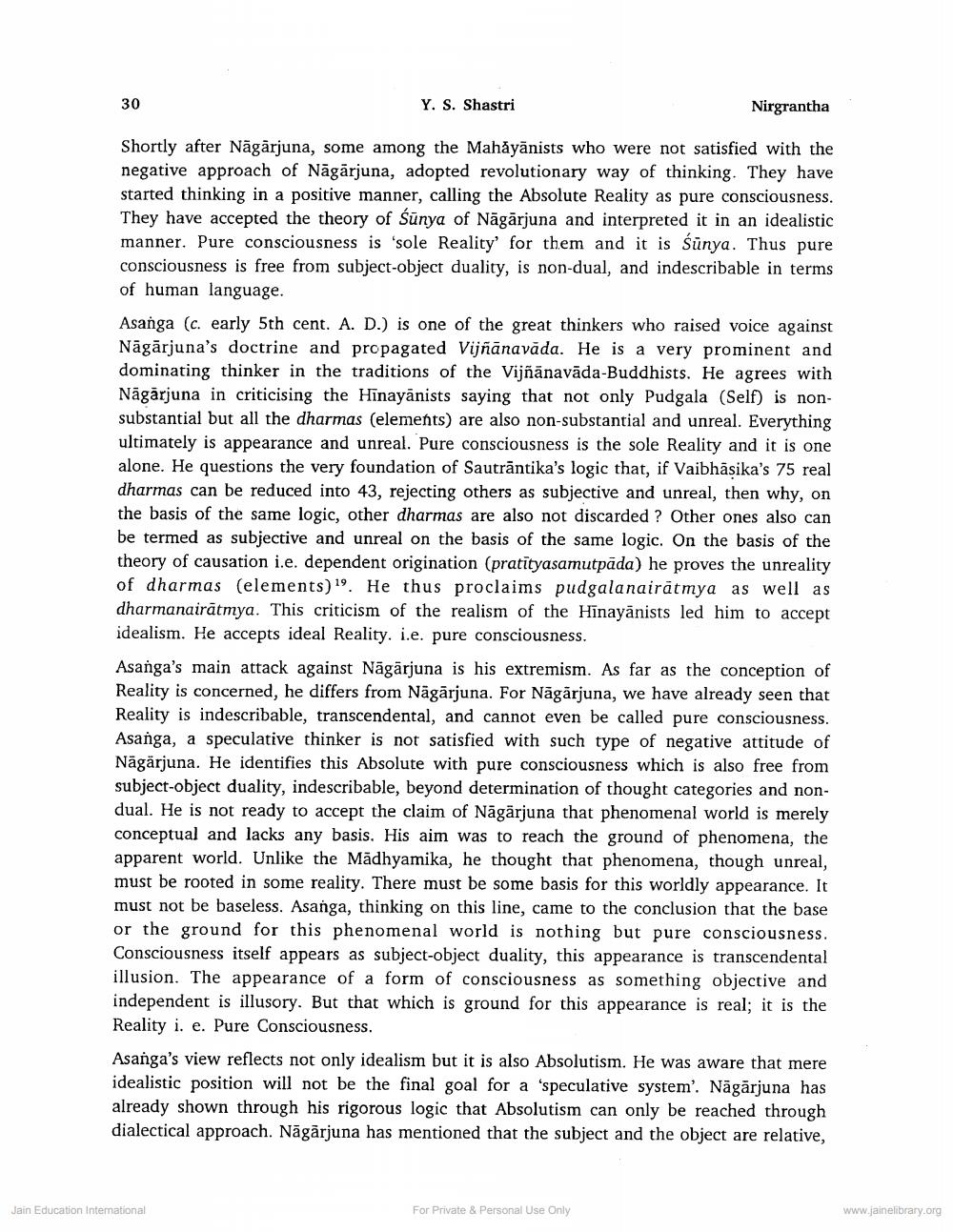________________
30
Y. S. Shastri
Nirgrantha
Shortly after Nägarjuna, some among the Mahāyānists who were not satisfied with the negative approach of Nāgārjuna, adopted revolutionary way of thinking. They have started thinking in a positive manner, calling the Absolute Reality as pure consciousness. They have accepted the theory of Sünya of Nāgārjuna and interpreted it in an idealistic manner. Pure consciousness is 'sole Reality' for them and it is śünya. Thus pure consciousness is free from subject object duality, is non-dual, and indescribable in terms of human language. Asanga (c. early 5th cent. A. D.) is one of the great thinkers who raised voice against Nāgārjuna's doctrine and propagated Vijñānavāda. He is a very prominent and dominating thinker in the traditions of the Vijñānavāda-Buddhists. He agrees with Nāgärjuna in criticising the Hinayānists saying that not only Pudgala (Self) is nonsubstantial but all the dharmas (elements) are also non-substantial and unreal. Everything ultimately is appearance and unreal. Pure consciousness is the sole Reality and it is one alone. He questions the very foundation of Sautrāntika's logic that, if Vaibhāşika's 75 real dharmas can be reduced into 43, rejecting others as subjective and unreal, then why, on the basis of the same logic, other dharmas are also not discarded ? Other ones also can be termed as subjective and unreal on the basis of the same logic. On the basis of the theory of causation i.e. dependent origination (pratītyasamutpada) he proves the unreality of dharmas (elements) "9. He thus proclaims pudgalanairātmya as well as dharmanairātmya. This criticism of the realism of the Hinayānists led him to accept idealism. He accepts ideal Reality. i.e. pure consciousness. Asanga's main attack against Nāgārjuna is his extremism. As far as the conception of Reality is concerned, he differs from Nāgārjuna. For Nāgārjuna, we have already seen that Reality is indescribable, transcendental, and cannot even be called pure consciousness. Asanga, a speculative thinker is not satisfied with such type of negative attitude of Nāgärjuna. He identifies this Absolute with pure consciousness which is also free from subject-object duality, indescribable, beyond determination of thought categories and nondual. He is not ready to accept the claim of Nāgārjuna that phenomenal world is merely conceptual and lacks any basis. His aim was to reach the ground of phenomena, the apparent world. Unlike the Madhyamika, he thought that phenomena, though unreal, must be rooted in some reality. There must be some basis for this worldly appearance. It must not be baseless. Asanga, thinking on this line, came to the conclusion that the base or the ground for this phenomenal world is nothing but pure consciousness. Consciousness itself appears as subject-object duality, this appearance is transcendental illusion. The appearance of a form of consciousness as something objective and independent is illusory. But that which is ground for this appearance is real; it is the Reality i. e. Pure Consciousness. Asanga's view reflects not only idealism but it is also Absolutism. He was aware that mere idealistic position will not be the final goal for a 'speculative system'. Nāgārjuna has already shown through his rigorous logic that Absolutism can only be reached through dialectical approach. Nāgārjuna has mentioned that the subject and the object are relative,
Jain Education International
www.jainelibrary.org
For Private & Personal Use Only




